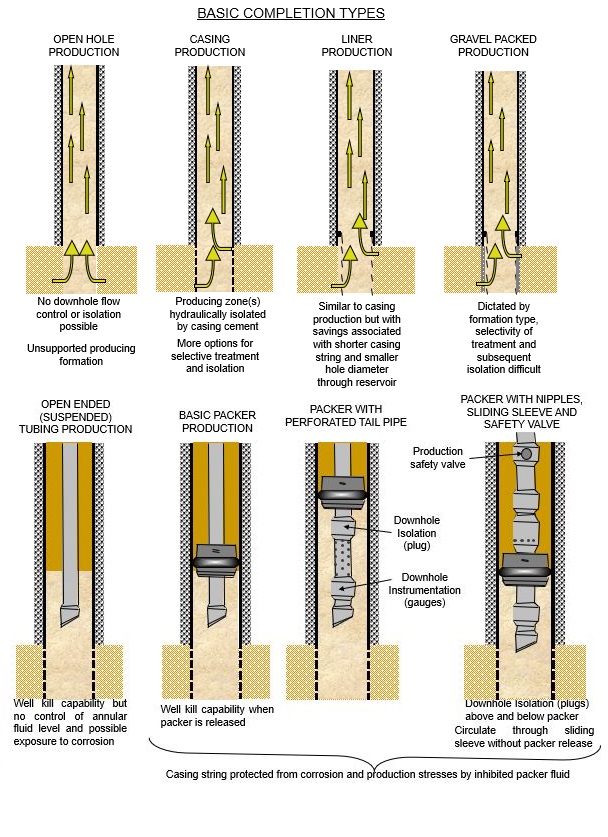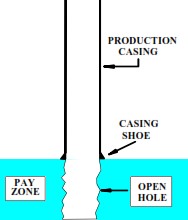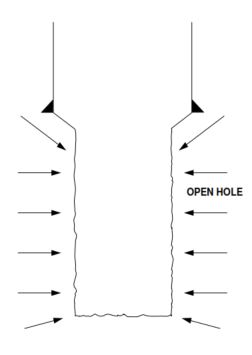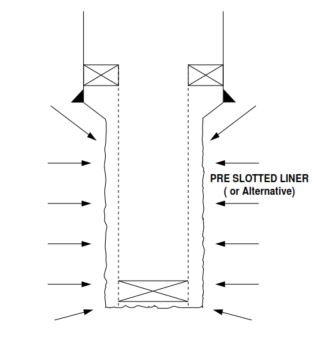
There are two basic types of well completions techniques:
- Cased hole completion
- Open hole completion
There is also another classification for well completion depending on the well Production Mode. This classification shall include the following:
- Single zone completion
- Multizone completion
- Dual string Completion
Open Hole Well Completion Type
The open hole completion has the production casing set above the target intervals. We complete such a well with the producing interval open to the well bore (see Figure 1).

Application
Their use is predominately in thick carbonate or hard sandstone reservoirs produced from fracture systems or thin permeable streaks, which are challenging to identify on logs and easily damaged by drilling and cementing operations. If we can avoid drilling and completion damage, they maximize the fracture intersections and inflow potential due to the large surface area.
However, they provide little or no selectivity in reservoir management to reduce unwanted water or gas production. Drilling Engineers can subsequently convert open hole completion to a liner completion to overcome the selectivity problem.
Often referred to as ‘barefoot’ completions, the completion method entails drilling down to a depth just above the producing formation and setting the production casing. Then we drill a hole through the formation, exposing it to the wellbore. After that, we complete the well with no casing set across the formation (Refer to figure below). The decision process depends on four key issues:

- Is there a risk of causing damage to well productivity with a cased and perforated completion?
- Do we require zonal selectivity?
- Is fracture stimulation essential?
- Is there any potential sand production?
Currently, engineers apply open-hole completions in a range of environments:
- Low-cost / multi-well developments
- Deep wells, consolidated with depletion drive
- Naturally fractured reservoirs
- Some horizontal and multi-lateral wells
Advantages
The most straightforward approach to bottom hole completion would be to leave the entire drilled reservoir section open after drilling, as shown in Fig 2. Many refer to such completions as ” barefoot, ” and the technique has a wide application. Since there are no need for equipment installation, there are savings in both costs and time. The primary advantages of open-hole completion are as follows:
- A low-cost completion alternative.
- Elimination of perforating expenses and production restrictions caused by the perforations.
- After setting the casing above the producing zone, mud engineers can mix a new non-damaging mud to drill the pay zone. Also, they can control the mud weight and chemistry to minimize formation damage within the zone of interest.
- Log interpretation is not critical as the entire pay zone is open to production, and there is no need for perforations.
- Maximum well bore diameter is opposite pay zone.
- Facilitate the well deepening
- Easily converted to other completion types (ie. casing liner completions).
Again, We should only apply open-hole completions in consolidated formations, as the borehole may become unstable once performing a drawdown to induce the well to flow. In such cases, either total collapse of the formation or the production of sand may occur.
Disadvantages
However, this completion type means that the entire interval is open to production, and hence it often provides no absolute selective control over fluid production or injection. It is, therefore, not recommended for production or injection wells where distinctive variations in lateral permeability will detrimentally control the sweep efficiency on zones under water flood or gas injection.
Further, if water/ gas breakthroughs or migration into the wellbore occurs in an oil well, it is difficult to isolate unless the entry is at the base of the well where isolation with a cement plug may be successful.
The possibility of interzonal cross flow or zonal back pressure dictating multizone depletion cannot be corrected with this type of completion. This lack of zonal control for production or injection is a significant limitation in applying this technique.

The main disadvantages of open hole completion:
- Excessive gas or water production is challenging to control.
- We set the production casing types before drilling the objective horizon. The pay zone’s extent is unknown until drilling the next hole section.
- The producing interval cannot be selectively stimulated.
- The open hole section may require frequent cleanouts if the formation is unconsolidated.
Cased Hole Completion


The basic cased hole completions types can be one of the following:
- Cemented/perforated casing,
- Cemented/perforated liner
- Uncemented/pre-perforated (or screen) liner completions.
- Fracture Stimulation
- Cased Hole Gravel Pack
A Perforated Casing Well Completion Type
In this completion type, we first perform a primary cement job for production casing through the producing zone. And then, we can selectively perforate the pay section (see Fig 2).

Cased hole Completion Advantages
- Excessive gas or water production is easier to prevent and control.
- Selectively stimulation is available.
- Deepening is still an option.
- The casing impedes sand influx and is adaptable to special sand control techniques.
- Full diameter through pay section.
- Logs can be available to assist the decision to run casing.
- Adaptable to several completion configurations.
- Minimum rig time required.
Disadvantages Of Cased Hole completion Type
- Perforating costs can be significant.
- Log interpretation is critical for selecting perforating interval(s).
- Greater danger of formation damage in the pay section since the mud that we used to drill from the last casing shoe is usually the same mud while drilling the pay zone.
- More expensive.
B Perforated Liner Well Completion Type
First, set the production casing above the producing zone. Then, drill the pay. After that, cement a liner across the pay zone. At the end, selectively perforate the liner for production (see Fig. 3).

Advantages
- Minimizing Formation damage since we can make up a new non-damaging mud before drilling the pay zone.
- Excessive gas or water production is easier to prevent and control.
- Selectively formation stimulation is an option.
- A liner can impede sand influx and is additionally adaptable to special sand control techniques.
- We can deepen the well after considering the liner & following hole sizes.
Disadvantages
- Limiting re-completion options for deeper formations if the production liner size is 4-1/2″.
- Log interpretation is critical for the correct perforating intervals.
- Additional costs are the liner and cementing expense, perforating expense, and additional drilling rig time.
- The pay zone’s extent is unknown until the end of the next hole section. That’s because of setting the production casing before drilling the producing zone.
C Screen/Pre-perforated Liner Completion
Firstly, set the casing above the completion zone. Secondly, install an uncemented screen or pre-perforated liner assembly across the pay section (see Fig. 4).

In this technique, once the drilling through the completed reservoir section has been completed, a wire-wrapped screen, steel pipe with slots, or an alternative sand control screen is installed (Fig 3). The principal purpose of the screen or liner is to prevent any produced sand from migrating with the produced fluids into the production flow string. Therefore, this completion technique is as an alternative to the open hole completion in situations where the reservoir rock consists of relatively large and homogenous sand grains.
The success of the completion in controlling sand production depends upon the screen or slot sizes and the sand particle sizes. The screen will only become 100% effective if it restrains sand production, which requires that the slot size be equal to the size of the smallest particles. However, in such cases, the slots may quickly become plugged and impede flow resulting in a loss in productivity. Sometimes, we use this system in inclined/high-angle angles to prevent major borehole collapse or facilitate the passage of logging tools.

Pre-perforated Liner Completion Advantages
- There is no wireline perforating expense. However, the cost of the pre-perforated/screen liner can be high.
- We can avoid cleanout problems in case of using proper screen/perforation size.
- Log interpretation is not critical since there is no requirement for wireline perforations.
- In addition, they are adaptable to unique techniques to control sand. A gravel pack or pre-packed liner is an option for this completion.
- Minimizing formation damage while drilling the pay since we can make up a new non-damaging mud before drilling the pay zone.
Pre-perforated Liner Completion Disadvantages
This technique also suffers from the same inability for zonal control of production or injection as in the open hole completion. It may only effectively control sand production over a limited range of conditions. However, it is a low-cost technique since the cost of a screen to cover the reservoir interval is much less than the cost of a casing string run to the surface, plus the cost of cementing and perforating. However, in the case of using premium sand exclusion screens, we can reduce the cost saving. The significant disadvantages of this type of completion are:
- Excessive water or gas production is difficult to control since there is no isolation (cement) behind the liner.
- Production casing is set before the producing horizon is drilled. The pay zone’s extent is unknown until the next hole section is drilled.
- Selective stimulation is not possible.
- Additional rig time is required to run the screen liner assembly compared to an open-hole completion.
- The diameter across the pay zone is reduced.
- The well cannot be easily deepened if the liner size is 4-1/2″. The hole size for deepening, in this case, is limited to 3-7/8″ (max).
D Fracture Stimulation
Fracture stimulation is used to increase the effective sand face area and to provide a high permeability flow path to the wellbore increasing the IPR from low permeability rocks (<25md).
The risk in fracture stimulation is that the fractures will likely not be contained within the pay zone, and the casing cementing program completion equipment rating, etc., would need to be designed with the additional loading of the stimulation operation.
E Cased Hole Gravel Pack
Cased hole gravel pack completions control sand production in perforated completions. Unlike the open hole gravel pack, the cased hole gravel is placed between the cased hole and the sand screen, ideally, with the gravel forced into the perforations holding the formation sand in place.
Since the gravel has a finite permeability, a large flow area must be achieved using ‘big hole’ charges with the maximum shot density (dependent on gun size).
Completion Types According to Well Production Modes
There are several optional methods by which fluid that enters the wellbore will be allowed to flow to the surface in a production well, or to the formation in an injection well. In selecting the method, a range of considerations may influence the choice, including cost, flow stability, ability to control flow, and ensuring well safety or isolation, ensuring that the integrity of the well will not be compromised by corrosion or erosion. In the case of the multizone reservoir, the zonal characteristics will determine to a large extent, the flow system selected.
Single Zone Well Completion Type
For a single zone completion, we have the following options (Figure 6):
- Tubingless casing flow.
- Casing and tubing flow.
- Tubing flow without annular isolation.
- Tubing flow with annular isolation.

We have previously discussed such options in the Single zone completion article.
Multiple Zone Well Completion Type
This type of completion has the significant advantage of controlling the production from 2 zones. We have spoken in more detail through our previous Multiple Zone Completion Post.

References
- NORSOK Standard D010, 2004. Wells integrity in drilling and operations.
- Petronas Well Engineering Manual
- Heriot-Watt University – Production Technology Book
- Well Completion Design (Volume 56)